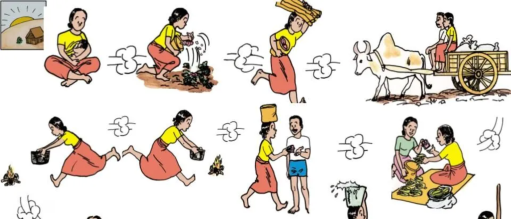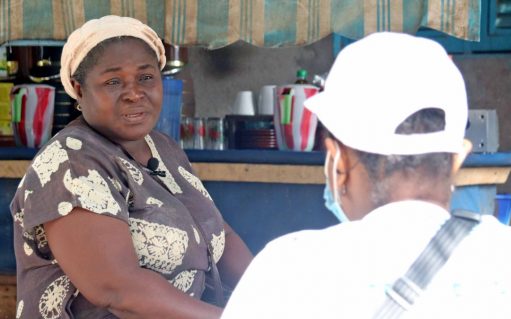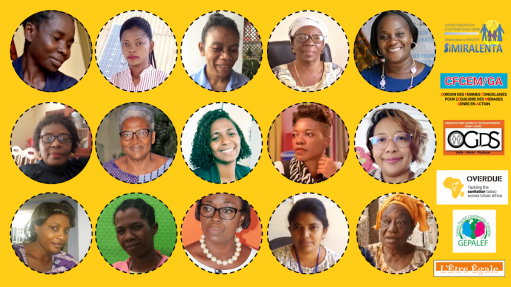The invisible burden of care work: women as producers of sanitation infrastructures
By Namita Kyathsandra, on 22 March 2023

Focus Development Association – Madagascar
This blog was written as part of the Learning Alliance between the OVERDUE project and the DPU’s MSc in Environment and Sustainable Development. Namita is a recent graduate of this MSc programme (2021/22), and her reflections on gendered sanitation infrastructures were produced in a module that tackles issues of environment and sustainable development in practice.
“It should be socially acceptable for women to wear diapers since we don’t have the freedom to urinate wherever we wish, as the men do!”
A frustrated aunt exclaimed during an 8-hour road trip when all the women in the car had to pee but could not, for the lack of toilets on Indian highways. The men, who had stopped multiple times since, to relieve themselves laughed off my aunt’s loud rumination.
I wondered why it was more intuitive for her to think of diapers before wishing for more toilets, in her moment of frustration. A redundant question, as I already knew that accessible, safe, and hygienic toilets for women along Indian highways are a utopian expectation.

Photo: A. Allen
It was after several such experiences that I realised that cities are not designed by or for women. The lack of toilets, streetlights, and accessible transport renders the urban space easier for the men to occupy and challenging for the women to navigate.
The simple fact that I, despite my privilege, often resorted to “disciplining my body” (Kulkarni, O’Reilly and Bhat, 2017)during road trips as a coping mechanism for the lack of decent toilets reveals the extent of the predicament faced by those from marginalised classes and vulnerable communities – their embodied and lived experiences made more adverse by their female bodies. The sociocultural notions of shame and modesty, purity and pollution and the stigmatization attached to bodily processes of women such as menstruation and excretion invisibilises their material and infrastructural needs thereby perpetuating themselves.
Thus far, my lived experiences around sanitation as a woman were always from the perspective of a user. Learning from, and with our partners in Mwanza and St. Louis, I discovered the significant role women play as the providers and producers of essential sanitation infrastructures. It was one thing to read an article about bodies as urban infrastructures (Truelove and Ruszczyk, 2022) as part of my coursework, and a completely surreal experience to witness it In real-time, through fieldwork informed by real women.
“The women carry the entire burden of sanitation, especially during the winter months. The women here help the men here, no sanitation, no pipes, the women empty the water”
acknowledged a man from the Focus Group Discussion conducted in Saint-Louis, Senegal.
Flipping the coin to view women as providers of sanitation, was a revelation. I realised how easily we dismiss women’s role in shaping urban processes specifically in water and sanitation although they are present in every sphere. It is the women who fetch the water and clean the toilets, filling the infrastructural gaps left by the governments. But they are hidden actors, their roles overlooked and under-represented.
‘Gender is not just a lens but a valuable analytical tool’ is an essential insight that I have gained through this journey. I realised it is like stained glass – look at your immediate world through it and what you will see is a different version – a different hue, a deeper saturation, set against a different mosaic.

Photo: P. Hofmann
In Africa, women perform a large bulk of care work involving activities like cleaning, cooking, and childcare. However, in the absence of effective sewerage systems in Mwanza and St. Louis, by performing sanitation work bracketed as ‘care work,’ women become the wardens and custodians of the sanitation chain. They perform the roles of essential urban sanitation infrastructures and are responsible for the maintenance of shared household toilets. They clean the toilets and empty the pit latrines without any bodily protection, motivated by the well-being of their families and children, exposing themselves to health risks and vulnerabilities emerging from routinely handling faecal matter.
Fundamentally, they are filling a critical gap in sanitation service provision, in the absence of which their settlement and city systems would collapse, especially during the winter months of severe flooding. However, their role is relegated to the ‘work’ that they are expected to perform for being born with a female body. Their contributions as providers of sanitation services are invisibilised, and unrecognised and their work is labelled as ‘duty.’ Although the sanitation responsibilities added to the burden of care, the women, aware of their role as sanitation service providers seemed content with the notion that they were only fulfilling their biological roles.
“When and how does care work become duty and duty become oppressive?”
is a question that underpinned the group research. The dissonance as to whether women should be materially compensated to ease the burden of sanitation, fulfilling practical gender needs, but perpetuating internalised gender roles or should they challenge the unequal power relations in their households and societies, bewildered me. However, learning from the African cities, I appreciated how similar lived experiences of women are across time and space, as both users and producers.
A bigger insight I gained was that women are present everywhere across the sanitation chain as both users and producers and possess specialized knowledge which can inform policy and practice and hence carry the immense potential to catalyse long-term socio-political change. Women play highly significant roles in the sanitation realm which benefits stakeholders across the scale of the household, the community, and the state.
Thus, just sanitation is not just about providing toilets and sewerage systems. It is about acknowledging and accommodating intersectional identities, embodied experiences, bodily dignity, safety, environmental concerns, and the health and wellbeing of everyone involved. Urban trajectories that do not consciously account for sanitation justice by acknowledging its gendered dynamics and fostering distributive, procedural and recognitional justice (Rusca, Alda-Vidal and Kooy, 2018) in sanitation, will most likely produce social injustices in urban spaces. Neglecting the significance of designing cities to provide just and equitable sanitation for women will generate inequitable outcomes, not just for the women but for the city.
For more information on the OVERDUE / MSc ESD Learning Alliance, please visit https://www.esdlearningalliance.net
Bibliography
Desai, R., McFarlane, C. and Graham, S. (2015) ‘The Politics of Open Defecation: Informality, Body, and Infrastructure in Mumbai’, Antipode, 47(1), pp. 98–120. doi:10.1111/anti.12117.
Kulkarni, S., O’Reilly, K. and Bhat, S. (2017) ‘No relief: lived experiences of inadequate sanitation access of poor urban women in India’, Gender & Development, 25(2), pp. 167–183. doi:10.1080/13552074.2017.1331531.
Rusca, M., Alda-Vidal, C. and Kooy, M. (2018) ‘Sanitation Justice?: The Multiple Dimensions of Urban Sanitation Inequalities’, in Boelens, R., Perreault, T., and Vos, J. (eds) Water Justice. 1st edn. Cambridge University Press, pp. 210–225. doi:10.1017/9781316831847.014.
Shukla, A.M. (2019) Mumbai: Unresolved civic issues irks residents, DNA India. Available at: https://www.dnaindia.com/mumbai/report-mumbai-unresolved-civic-issues-irks-residents-2736710 (Accessed: 26 May 2022).
Truelove, Y. and Ruszczyk, H.A. (2022) ‘Bodies as urban infrastructure: Gender, intimate infrastructures and slow infrastructural violence’, Political Geography, 92, p. 102492. doi:10.1016/j.polgeo.2021.102492.
 Close
Close




















